Jupiter's Statistics
| Planetary Symbol: |
 |
Name in Roman/Greek Mythology: |
Jupiter/Zeus |
| Diameter: |
142,800 km
(88,736 miles) |
Rotation Period about Axis: |
9.8 hours |
| Mass: |
1,898 x10^24 kilograms (318 x Earth's) |
Revolution Period about the Sun: |
12 years |
| Density: |
1,326 kg/m^3 |
Tilt of Axis: |
3.1o |
| Minimum Distance from Sun: |
741 million km
(460 million miles) |
Surface Gravity: |
23.12 m/s^2 (2.64 x Earth's) |
| Maximum Distance from Sun: |
817 million km
(508 million miles) |
Distance across the Great Red Spot: |
40,000 km
(24,860 miles) |
| Orbital Semimajor Axis: |
5.20 AU (Earth=1 AU) |
Temperature at Cloud Tops: |
-150o C (-101o F) |
| Minimum Distance from Earth: |
588 million km
(365 million miles) |
Average Cloud Top Temperature (K): |
123K |
| Rings: |
1, very thin |
Satellites: |
known |
 Jupiter Image Archive
Jupiter Image Archive
 Comparative Planetary Statistics -- in table form
Comparative Planetary Statistics -- in table form
 Comparative Orbital Statistics -- in table form
Comparative Orbital Statistics -- in table form
 Actual Distance to Earth
Actual Distance to Earth
 News from NSF: A Newly Discovered Solar System Contains Scaled-Down Versions of Saturn and Jupiter (2/14/08)
News from NSF: A Newly Discovered Solar System Contains Scaled-Down Versions of Saturn and Jupiter (2/14/08)
 Podcasts from NSF: Systemic Search
Podcasts from NSF: Systemic Search
You might also be interested in:

A team of international astronomers reports in the Feb. 15 issue of Science the discovery of a solar system nearly 5,000 light years away containing scaled-down versions of Jupiter and Saturn. Their findings
...more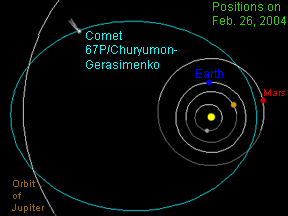
Comet 67P/Churyumov-Gerasimenko was discovered in 1969 by Klim Churyumov and Svetlana Gerasimenko. The comet orbits the Sun once every 6.57 years. Its orbit brings it closer to the Sun than Mars at the
...more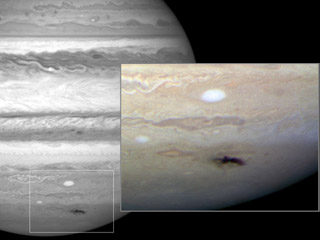
On the night of July 19, 2009, Anthony Wesley noticed a dark splotch on Jupiter that hadn't been there before. Wesley, an amateur astronomer in Australia, had discovered the remnants of a huge impact on
...more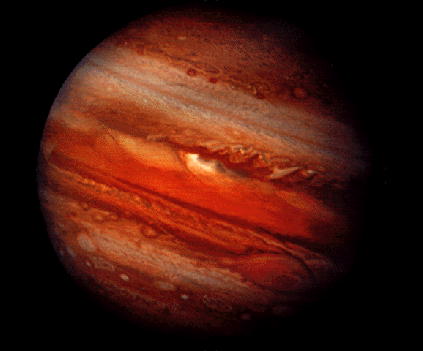
Jupiter is the largest planet in our solar system. It is also one of the brighter objects in the night sky. No one knows for sure who discovered Jupiter, but we know the ancient Greeks named him after
...more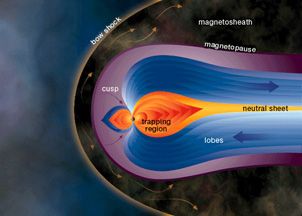
Jupiter's magnetosphere is a unique object in the solar system. It is the biggest object in the entire solar system. Not only is it big enough to contain all of Jupiter's moons, but the sun itself could
...more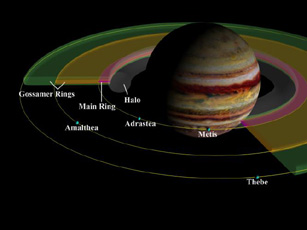
Jupiter has a series of rings circling it! Unlike Saturn's rings, which are clearly visible from Earth even through small telescopes, Jupiter's rings are very difficult to see. So difficult, in fact, that
...more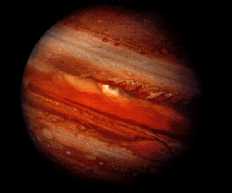
Atmospheres of the giant planets have definetely evolved from their formation out of the primitive solar nebula. How much they have evolved remains to be seen, however. Because of their enormous gravity,
...more

 Comparative Planetary Statistics -- in table form
Comparative Planetary Statistics -- in table form
 Comparative Orbital Statistics -- in table form
Comparative Orbital Statistics -- in table form
 News from NSF: A Newly Discovered Solar System Contains Scaled-Down Versions of Saturn and Jupiter (2/14/08)
News from NSF: A Newly Discovered Solar System Contains Scaled-Down Versions of Saturn and Jupiter (2/14/08)
 Podcasts from NSF: Systemic Search
Podcasts from NSF: Systemic Search


 Jupiter Image Archive
Jupiter Image Archive











